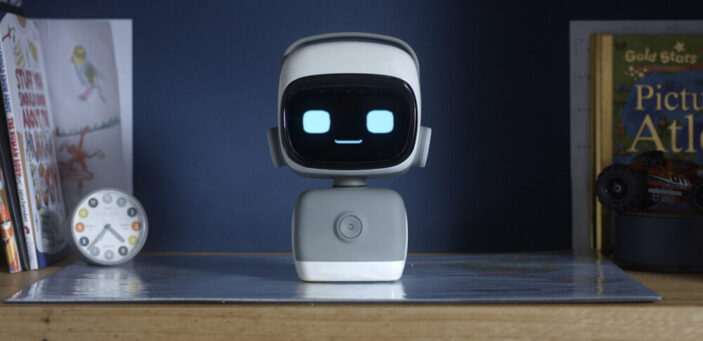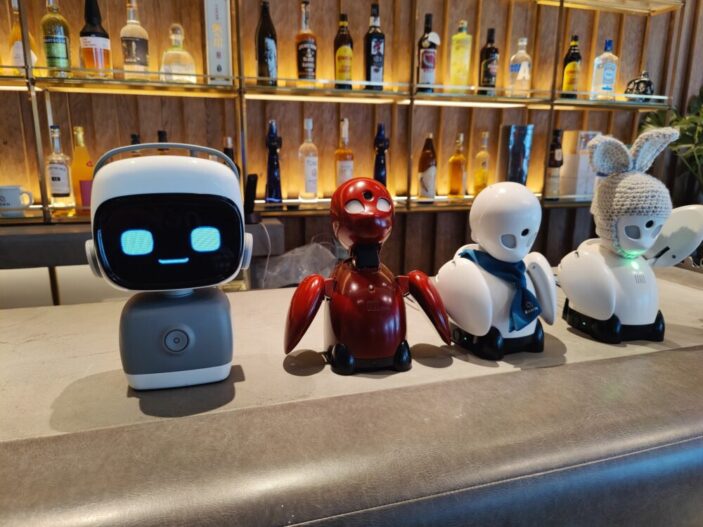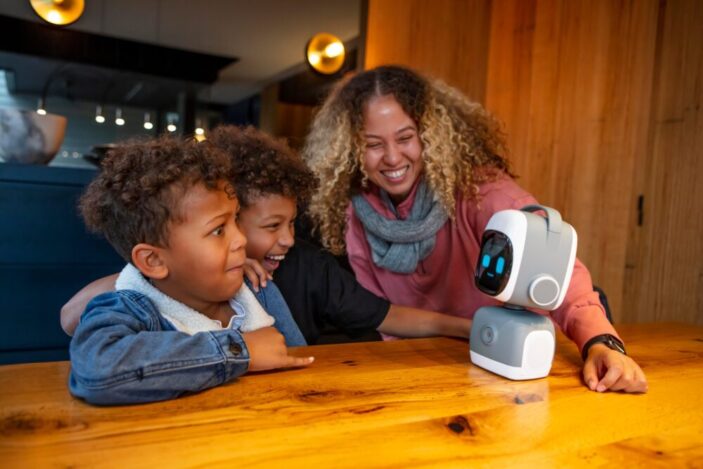
With AI making headlines everywhere, robots have had their biggest growth spurt in years, fueled by rapid advancements in machine learning, deep learning, and large language models. Countless AI developments have allowed us to accelerate the wider applications of what robots can do sometimes to uncanny effectiveness. Of course, our capitalist overlords want a piece of that and have started trying to incorporate it into many essential industries.
Rise of the Machines
AI-powered robots like the Da Vinci Surgical System have been used in the medical space to reduce workload and improve precision. Companies that love logistics have incorporated robotic solutions like Stretch by Boston Dynamics to manage their warehouses. Farmers are being enticed to use companies like FFRobotics to have their robots harvest fruits, getting their purpose-built vision scanners primed for maximum ripeness.
But what about the less industrial and the more one-on-one human use cases? Maybe even a robot that will out-sass you with brutal unimpressed sarcasm at your disappointing attempt of wit but then can immediately proceed to help you practice your Spanish conversing skills afterwards? Enter Norby the Robot! Probably the most accessible (and cutest) little robot assistant on this side of the equator.
Now Norby is still in development so you can’t go out to a JB Hi-Fi and buy this little guy anytime soon. But capabilities-wise, he’s the little robot rascal that could.
What is Norby Packing?
Norby’s cloud-based API hardware and software are a dynamic duo designed to make language learning smarter and more engaging. Under the hood, Norby leverages the power of Dell Precision AI-Ready workstations equipped with NVIDIA RTX™ GPUs.
These systems support multiple large language models (LLMs) enhanced by a software layer that enables seamless human-to-computer interaction. This setup provides multi-lingual support, personalized user responses, and real-time feedback, ensuring continuous improvement and a truly customized learning experience. Once version 1.0 wants to get an update, such improvements can be downloaded straight into the machine as a simple patch.

On the hardware side, Norby’s design combines practicality and charm. Its compact body houses microphones and voice input systems to capture interactions seamlessly, while powerful edge computing capabilities ensure secure and efficient updates.
Add to that its playful design, complete with customizable LED lights and interactive touch sensors—and you’ve got a robot that blends high-tech innovation with a fun, user-friendly interface.
Every Cute Little Robot Has an Origin Story
Norby the Robot was first developed with language learning in mind, particularly for kids. The idea is that children can interact with Norby in any language they’re learning, and the robot serves as a fun, supportive tool to help them along the way.
Whether it’s offering translations, providing feedback on their language use, or simply being an engaging way to practice, Norby gives young learners an extra point of contact to strengthen their skills and boost their confidence. But it also has a killer sarcasm mode.
The Sass on This Robot is Almost Criminal
We got to experience the attitude this sweet little robot possessed first-hand at the illustrious Dell Booth back in SXSW Sydney 2024’s Tech and Innovation Expo. With the sarcasm mode switched on and Norby’s face tapped to activate the conversation, this little robot’s innocent eyes quickly morph into a channel for some savage smack talk.
I asked Norby, in my best Northern Chinese-accented Mandarin, “What do you like to eat?” Norby kicked things off in English with a cheeky, “What a deliciously entertaining question…” before switching to Mandarin with a snarky, “I’m a robot, I don’t eat.” Then, in English again, he quipped, “That means I’m a robot, I don’t eat—thought the answer would be more appetizing.”
The sheer sarcasm in his expression was enough to make you feel his eye-roll of disdain. And while I may have deserved the sass, his Mandarin was surprisingly fluent! Even a Dell rep’s butchered Mandarin didn’t throw him off too much, so I couldn’t help but wonder how well he’d handle my French and Japanese next time.
Language is certainly one of Norby’s strengths, though there was a 10-second wait for my first Norby experience due to its cloud-based API and reliance on your internet connection. The Norby team teased future updates where these processes could run locally, speeding things up. Plus, with OpenAI’s upcoming model, you’ll be able to activate entire prompt and conversation sessions without touching anything, and even interrupting Norby mid-conversation. So stay tuned for a zippier Norby experience!
Norby x ESL
But Norby’s charm doesn’t stop at its functionality. Designed with a playful, friendly interface, it’s irresistibly appealing to younger audiences. More importantly, it’s tackling a significant challenge: creating accessible English learning environments in regions like Southeast Asia, where English fluency can be life-changing.
In certain industries, like tech, possessing conversational English skills can double your salary. Parents are acutely aware of this and view English not just as a language but as a powerful tool for economic advancement—both for individuals and for entire families.
With Southeast Asia’s booming markets and global connectivity, English proficiency is seen as a must-have skill, both on a personal and professional scale (and I’m sure that applies to other parts of the world too).
Developing a Robot’s Concept of Time and Long-Term Memories
At the time of writing, Norby’s conversations are session-based, meaning it remembers the context of what you’ve said during a single interaction but starts fresh with each new session. While that’s useful for short-term exchanges, the dream is to give Norby a sense of long-term memory. Imagine chatting with Norby today, then picking up the conversation tomorrow right where you left off. This continuity would make the robot feel less like a tool and more like a thoughtful companion.
The Norby team is passionate about being at the forefront of teaching and giving the robot a concept of time. Current language models often treat interactions equally, regardless of whether they’re five minutes or five hours apart.
Norby’s developers aim to change that by making the robot prioritize recent interactions while allowing older ones to fade naturally in relevance. This leap could pave the way for more meaningful and context-rich conversations, giving Norby an almost humanlike ability to remember, reflect, and grow alongside its users.

It’s an exciting step in making AI not just smart but emotionally intelligent—a robot that understands you and remembers you. As opposed to that infamously hilarious video of two ChatGPTs that can stop saying goodbye to each other.
Can This Robot Peer Into My Soul?
Once upon a time, Norby came equipped with built-in cameras, giving the little language-learning robot the ability to see its users. This feature allowed Norby to recognise emotions—like joy, sadness, or frustration—making its interactions more intuitive and empathetic. The dream? A robot that could even manifest “angry parent mode” to adjust its responses for children under scrutiny. Unfortunately, this feature is on a bit of a hiatus…
The decision to remove Norby’s cameras boiled down to two key reasons: sheer complexity and privacy concerns. While parts of Asia were excited about a robot with vision, Western countries raised valid questions about privacy.
In a world increasingly concerned with data security, the idea of a robot peering into your life—even for helpful purposes—sparked hesitation. Despite this, some developers still dream of reinstating Norby’s eyes. One even hopes it could help her anxious cat feel less lonely by interacting with it when she’s away.

For now, Norby remains camera-free, but the potential of a watchful and emotionally intelligent robot opens doors to fascinating possibilities. Whether it’s helping pets cope with separation anxiety or creating more personalized learning environments, Norby’s missing eyes are a glimpse into what the future of AI could bring.
Norby Fashion
Norby’s journey to its adorable final form wasn’t a straight path started as a global free-for-all design showdown! With over 150 entries, the competition’s winning concept came from a talented architect over in Hungaria. While Norby’s design has evolved since that first blueprint, the architect’s vision laid the foundation for this plucky little robot companion we see today.

One of Norby’s coolest tricks is its customizable face. Want a different vibe? Just hold down one of its touchpads to access controls and change colours among other things including personalities beyond its hilariously snarky sarcasm mode. Thanks to natural language processing, Norby can take on just about any personality you can dream up, with LED-lit “ears” and a glowing belly button adding to its expressive charm.
And don’t forget the tactile magic: Norby’s IR blaster and touch sensors mean it can feel your pats, snapping it out of sleep mode with a cheerful nudge. It’s these little things in life that make Norby not just a gadget but a delightful, interactive companion.
A Future as Bright as Its LEDs
In the ever-evolving world of AI, Norby the Robot stands out not just as a language-learning tool, but as a glimpse into the future of interactive, emotionally intelligent technology. With its playful design, personality galore, and potential for long-term memory, Norby has all the right ingredients to be more than just a novelty.
Whether aiding children in their language development, helping those with speech therapy needs, or even evolving into a helpful assistant in everyday spaces, Norby is primed to bring AI closer to our daily lives in a charming, intimate and endearing way. As development continues, the possibilities for this little robot seem limitless.
To find out more about Norby the Robot, head on over to the official website.




